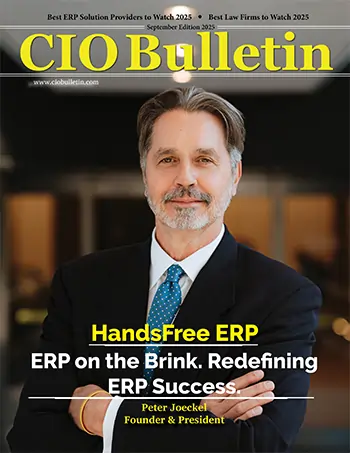30 Admired Companies to Watch 2021
CIO Bulletin

Enterprises today need networks that are secure and enable digital transformation. While wired networks are too expensive and impractical, Wi-Fi is not a reliable solution for these enterprises. There is no one-size-fits-all strategy for enterprises, even for those in the same industry. Private Wireless Networks are lately being seen as the savior that holds the potential to address this gap. Pushing the envelope for Private Wireless Networks is a well-known Infrastructure-as-a-Service solutions provider ClearSky Technologies. The Orlando, FL-based company is really about understanding its customers’ current challenges and future goals and partnering with them to address their business needs.
We recently interviewed ClearSky Technologies’ Rob Cerbone, SVP of Product Management, one of the Wireless industry's true pioneers. He shed some light on the importance of adopting Private Wireless Networks and how it can help deliver a host of new applications and services that will enable Industry 4.0. Read on for the excerpts from the interview.
ClearSky was a Managed Service Provider to Mobile Network Operators. What changes in the industry attracted ClearSky to the enterprise business as opposed to the traditional carrier-focused customer base?
Enterprises are increasingly looking for new technologies to improve their operational efficiency, reduce costs, elevate customer service, and deliver new applications and services. This year, the Federal Communications Commission approved an innovative new shared radio frequency model for 150 MHz of wireless spectrum in the 3.5 GHz band. The Citizens Band Radio Service (CBRS) offers the widespread availability of no-cost or cost-effective FCC licenses that enterprises can use to build Private Wireless Networks. Unlike Wi-Fi, which is an unlicensed spectrum accessible to any device within a Wi-Fi frequency band, CBRS licenses are dedicated licenses just like the Mobile Network Operators (MNOs) use, except that they are allocated within a shared frequency band. Leveraging LTE technology today, and soon 5G, enterprises can now experience the Quality-of-Service, low latency, high security, and unrivaled mobility associated with cellular networking technology. Private Wireless Networks will not only address existing applications that have subpar performance on Wi-Fi but also deliver a host of new applications and services that will enable Industry 4.0. Given our expertise in operating mobile Infrastructure-as-a-Service for 20 years, we saw an opportunity for ClearSky to drive the enterprise adoption of Private Wireless Networks while reducing the complexities associated with operating them.
Why would an enterprise want to use a Private Wireless Network if they already have Wi-Fi?
Wi-Fi networks are an excellent tool for CIOs. In fact, I spent several years building Wi-Fi networks for small businesses, enterprises, and venue customers when I was at Time Warner Cable. Wi-Fi is ideal for general purpose internet browsing and is compatible with a wide variety of devices. However, Wi-Fi is not ideal for the mission- or business-critical applications that require guaranteed throughput, low latency, true security, or mobility. We recommend keeping Wi-Fi networks for general-purpose connectivity but migrate mission- or business-critical connectivity to a Private Wireless Network. For example, there may be hundreds if not thousands of devices trying to connect to a Wi-Fi network in a hospital setting. Wi-Fi and its first-come-first-serve approach cannot prioritize traffic or users. With Private Wireless Networks, we can define the applications, devices, and users that get priority on the network. We can ensure that a sensor monitoring a patient’s vital signs always gets priority over a sensor tracking the location of an asset like a wheelchair.
Why would an enterprise want a Private Wireless Network if they can get cellular service from a big carrier like AT&T, Verizon, or T-Mobile?
Cellular service is great for wide-area applications, but its coverage is increasingly challenged in buildings as new, energy-efficient building materials hinder cellular transmissions and higher frequency bands suffer from poor propagation through walls. Also, the MNOs have been shifting more of their spend away from in-building coverage towards outdoor network densification for 5G. While enterprises can pay to improve their in-building coverage for MNO cellular services, they have no control over the MNO network's policy management. The cost can also be an issue as every device connected to an MNO’s network will be charged access and usage fees. A Private Wireless Network gives you the best of both worlds, a licensed mobile wireless network using proven cellular network infrastructure with the control of your corporate LAN. Enterprises benefit from the reliability, guaranteed throughput, Quality-of-Service, security, and mobility of a cellular network while also maintaining the ability to create detailed policies for users, devices, or applications, all without the ongoing charges from an MNO.
How has COVID-19 impacted the deployment of Private Wireless Networks?
The impact has been mixed, with some industries accelerating deployments, others slowing down, and new use cases emerging. For hospitality and commercial real estate, activity has slowed, as people are working remotely and not traveling as much for business or pleasure. Existing projects that have been funded may move forward, taking advantage of the reduced utilization of the facilities. Industrial properties have been active, driven by Industrial Internet of things (IIoT) applications that enable enterprise transformation to achieve cost savings or efficiency improvements. Private Wireless Networks are also being implemented as a secure, reliable method to extend healthcare networks outside medical facilities to facilitate patient screening for COVID while maintaining compliance with HIPAA and other regulatory compliance. We have also seen an explosion of demand for fixed wireless applications in the education vertical to accommodate remote learning in K-12.
The Leader Upfront
Rob Cerbone, SVP of Product Management
He is responsible for the strategy go-to market planning, and product development of ClearSky’s Private Wireless Network Managed Services. Rob is a seasoned product management executive with over 20 years of experience launching new products and services in the telecom and wireless industries. Rob was formerly the Vice President and General Manager, Wireless within Time Warner Cable’s Broadband Services organization where he was responsible for TWC’s mobile strategy and led the buildout of one of the largest public Wi-Fi networks in the US.
“Wi-Fi is not ideal for the mission- or business-critical applications that require guaranteed throughput, low latency, true security, or mobility. We recommend keeping Wi-Fi networks for general-purpose connectivity but migrate mission- or business-critical connectivity to a Private Wireless Network.”

Insurance and capital markets







